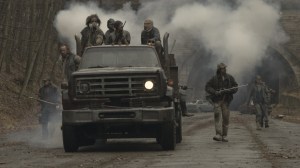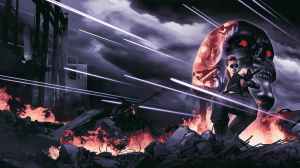The Walking Dead: World Beyond declassifies intel on the Civic Republic Military’s growing plan to end the zombie apocalypse and eradicate empties from the planet. Spoiler warning for Season 2 Episode 2, “Foothold.“ A decade after the global outbreak of the zombie virus that turns the infected into the flesh-feasting undead, brilliant biochemist and geneticist Dr. Leo Bennett (Joe Holt) works towards a cure at a Civic Republic Research Facility in New York State. In this fight for a future, Lt. Col. Elizabeth Kublek (Julia Ormond) and the CRM recruit Dr. Lyla Belshaw (Natalie Gold) and other assets — like Leo’s gifted daughter Hope (Alexa Mansour) — to build an apparatus of knowledge and research to save humanity.
Videos by ComicBook.com
Test Subject A
In a post-credits scene ending Season 1, Episode 4, “The Wrong End of a Telescope,” Civic Republic scientist Dr. Belshaw conducts empties experiments on her zombie-bitten colleague Dr. Samuel Abbott (S.J. Ovaska). Labeled “TS A 4.0.2.,” the reanimated Abbott is among dozens of walkers muzzled and strapped to gurneys inside the testing facility.
Belshaw records her notes into a voice recorder: “Test subject displayed no detectable responses to psychological stimuli. Necrotic plasma and brain fluid are being drawn for further testing. Results to be compared to tests performed during and immediately following reanimation. Tomorrow we’ll begin the climate variation tests as scheduled.”

Decontamination
In Season 2 Episode 2, “Foothold,” CRM prisoner Silas (Hal Cumpston) is remanded to a decontamination center miles away from the Research Facility where Belshaw works with Bennett. He’s put to work with decon crew Webb (Jesse Gallegos), Tiga (Ry Chase), and Grady (Kellen Joseph Quinn), who use modified catch poles called kill sticks to do their dirty work.
The decontamination center lures in the dead with lights and music before blowing them up and cleaning up the remains, trucking the blasted body parts away off-site.
Mechanic Dennis (Maximilian Osinski) reveals the decontamination center is the first of its kind. Now there are six larger decontamination centers across New York State — converted stadiums and arenas — each operated by trained military personnel.
They’re “playing a role in an experiment in mass culling,” explains Dennis. “And if the modeling’s right… we can clear out the state while the measures keep more from coming in. We can gain a foothold. We can start to bring back what this place had in energy, agriculture, commerce. This? This is a training ground for that.”

Eradicating Empties
On a tour of the CR Research Facility where Hope is reunited with her father in “Konsekans,” Belshaw reveals the campus was once a government-funded educational research lab before the fall. The lower levels are where the bright minds of the Civic Republic are “laying the foundation to one day find out why the world turned.”
Finding a cure is more about “pinpointing what inside us makes us turn — whether it be fungal, bacterial, viral, or something else entirely,” Belshaw says. “But it’s also about finding a way to get rid of the ones who have already turned. By investigating and hopefully discovering what keeps the dead animated, what inside them slows their decomposition rates and feeds their appetite, we hope to one day turn off those triggers, eliminate the dead as a threat, and eradicate them from the earth.”

Biorecorders
Belshaw shows Hope a pre-recorded video of Dr. Bennett addressing their partners in the CR, part of the Alliance of the Three — the once united communities of Omaha, Portland, and the Civic Republic — bound by the Three-Circle symbol.
In the video presentation, Bennett narrates footage of an empty wearing a biorecorder device strapped to its back. Scientists fuse biorecorders to the brain stems of empties, giving them the ability to record and transmit the dead’s biological response to environmental stimuli — providing invaluable tracking data to help approximate and predict behavior.
The CR spent years developing the technology that Bennett cracked in two months. The program is in its infancy, he says, but has allowed CR researchers to collect “troves of information — small variations in brain chemistry, variations in speed, implying pursuit behaviors, the effect of weather on movement and awareness – massive amounts of data that will open the doors to further avenues of research.”

Neutralizing the Dead
Bennett’s research involves infecting the dead with strains of fungi that grow on necrotic flesh. He posits: “It’s conceivable if we can modify an existing fungus, then we can one day accelerate the dead’s rate of decay, virtually neutralizing them as an active, mobile threat.”

The Future
If the CRM can decontaminate and eventually neutralize empties — even the “columns,” what the CRM calls massive herds of the dead roaming the world — it’s possible this “mass culling” can clear entire states of walkers. In time, Kublek envisions a future where the living reclaims the world from the dead.
New episodes of TWD: World Beyond Season 2 premiere Sundays on AMC and AMC+. Follow the author @CameronBonomolo on Twitter for all things TWD and stay tuned to ComicBook for coverage all season long.








